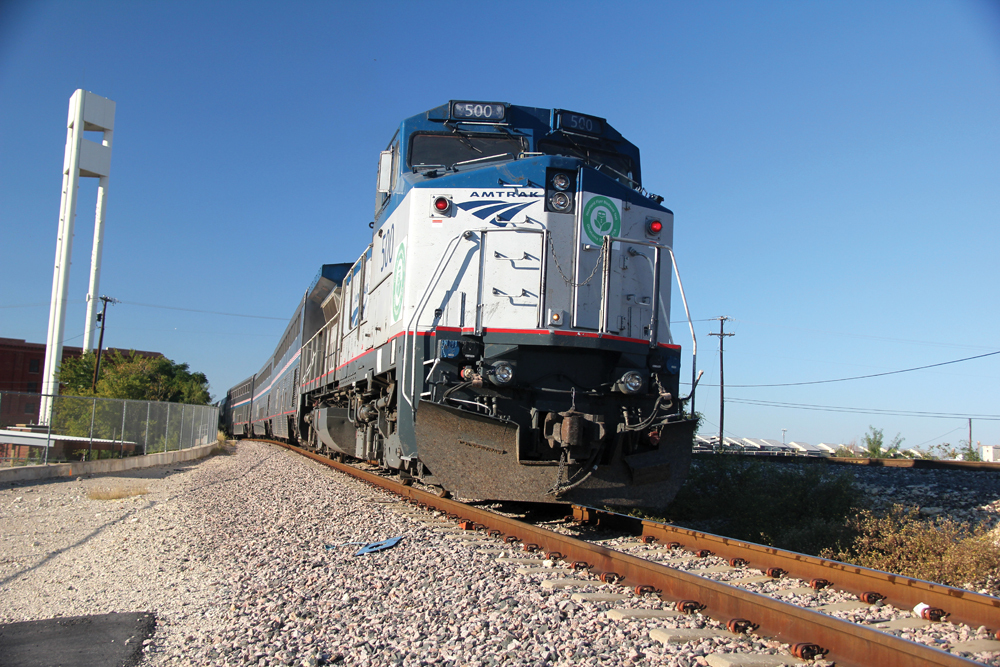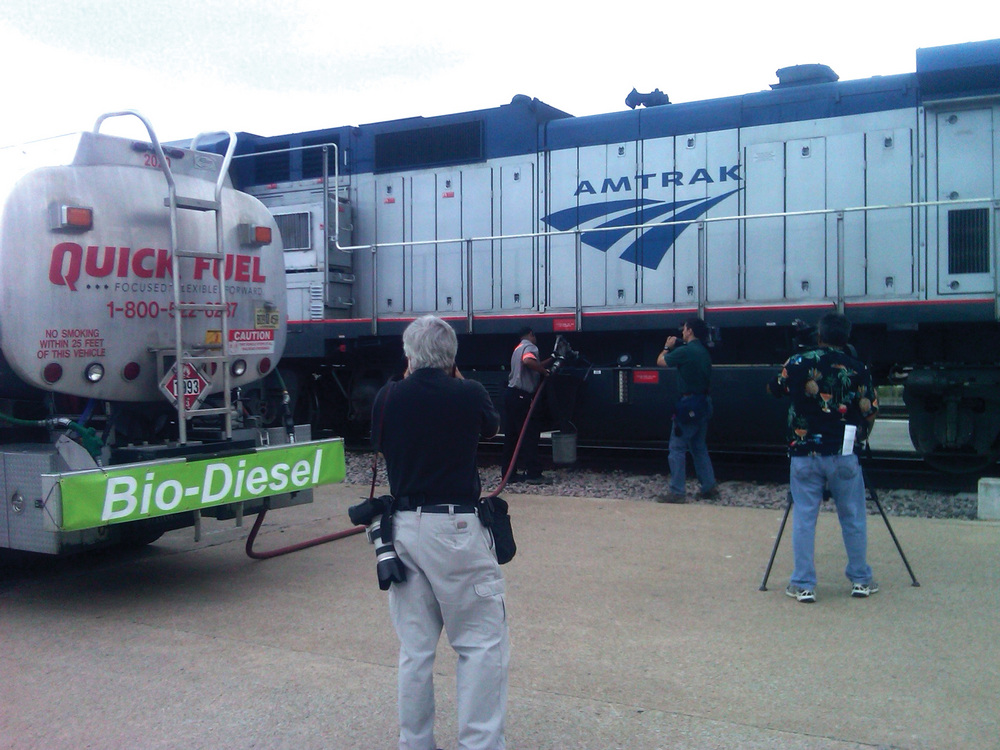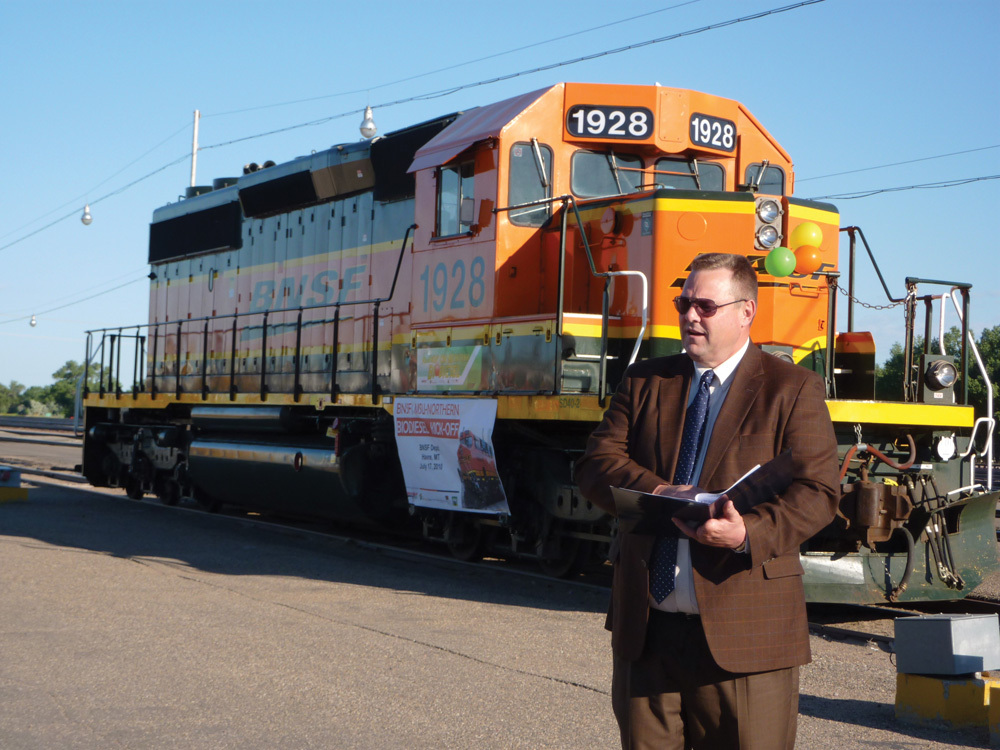Steaming Ahead to a Better Fuel




PHOTO: AMTRAK
June 14, 2011
BY Erin Voegele
The railroad is already considered one of the most environmentally sustainable and efficient ways to transport freight. Although most railways address fuel efficiency in terms of gallons-per-mile rather than miles-per-gallon, the sheer volume of cargo that can be moved by a single train results in a highly efficient operation.
The U.S. Surface Transportation Board defines three primary categories of railroads in the U.S.: Class I, Class II, and Class III. Short-line railroads, those with annual operating revenue of less than $20 million, are primarily classified Class III. Regional railroads, those with annual operating revenue between $20.5 million and $277.7 million, are generally classified as Class II. The largest railroads in the U.S., defined by the STB as having annual carrier operating revenues of $250 million or more—are classified Class I. Currently, seven rail lines in the U.S. are recognized as Class I, including Burlington Northern Santa Fe, CXS Transportation, Canadian National/Grand Trunk, Kansas City Southern, Norfolk Southern, Soo Line and Union Pacific.
According to the Association of American Railroads, Class I railroads alone operated more than 94,000 miles of track in 2009, with 24,047 locomotive engines in service. During the same year Class I railroad operationed 1.53 trillion ton-miles. A ton-mile equates to 1 ton of freight moved one mile. Furthermore, the AAR estimates that the average Class I train transported 3,546 tons of cargo 919 miles per trip.
Most locomotive engines in the U.S. are powered by diesel, and the fuel they use to transport freight is not insignificant. Data published by the STB illustrates that the seven Class I railroads consumed nearly 964 million gallons of fuel during the first quarter of 2011, which is a slight increase over the more than 900 million gallons of fuel the same railroads consumed during the first quarter of 2010.The U.S. Energy Information Administration estimates that more than 2 billion gallons of distillate fuel oil were used by the railroad in 2009, representing a fraction of the 34 billion gallon on-highway market. However it is important to note that even a 2 billion gallon market represents the opportunity to blend 100 million gallons of biodiesel into a B5 blend, or 400 million gallons of biodiesel into a B20 blend of fuel.
Some railroads are beginning to recognize the benefits associated with employing a renewable fuel in their operations. In fact, Amtrak and BNSF Railway Co. are each participating in long-term B20 trials. While there are obvious benefits of using renewable fuel in terms of energy security and reduced carbon emissions, those who wish to fuel locomotive engines with biodiesel face a different set of challenges than those using the fuel in on-road operations.
“The railroad industry is a bit different than trucking in that we use our locomotives for a very, very long time,” says Marc Magliari, Amtrak’s media relations manager, noting that there are still some locomotives in the U.S. that have been operating for more than 50 years. Perhaps most importantly, the reliability has to be incredibly high in order for biodiesel to be used commercially by railroads. While a company running a trucking fleet likely has ‘spare’ trucks that can be utilized if biodiesel-associated issues pop up unexpectedly with one engine, the railroads do not have that luxury. Any fuel that a locomotive uses has to have little or no impact on locomotive reliability and availability, says Magliari. There really aren’t spare locomotives a railway company can rent or otherwise utilize if one in their fleet becomes inoperable for a period of time.
Amtrak Trial
Advertisement
Amtrak kicked off a one-year B20 trial in the spring of 2010. The trial, which wrapped up May 15, focused on the Heartland Flyer, a P32 model train purchased in the late ’90s that travels between Ft. Worth, Texas and Oklahoma City, Okla. While it will take several months to compile and analyze the data gathered during the trial, Roy Deitchman, Amtrak’s vice president of environmental, health and safety, says preliminary results seem to indicate the fuel’s performance has been acceptable. “For the Amtrak part of the trial, we’re very happy with the performance,” he says. Magliari adds that the trial resulted in no problems related to operational reliability.
The biodiesel fuel used in the trial has been manufactured using beef tallow as a feedstock. Magliari stresses that this was not an intentional decision made by Amtrak, rather beef tallow biodiesel simply happened to be locally available. The B20 was splash blended in a truck using ULSD, and directly introduced into the locomotive. In other words, the B20 blend was not stored in a tank prior to fueling the train.
The trial, which was funded with a $274,000 Federal Railroad Administration grant along with support from the Texas and Oklahoma departments of transportation, includes several discrete components. Two of the 16-cylinder engine’s assemblies were replaced with brand-new components at the start of the trial. According to Deitchman, detailed measurements of the gaskets and assemblies were taken at the start of the trial. Following the competition of the trial, a comparative set of measurements was taken.
Emissions testing is also being completed as part of the project. “A locomotive is difficult to emissions test,” Deitchman continues. “It has to go on a specially built dynamometer, and there are only two or three places in the U.S. that do that testing.” For Amtrak’s trial, the Heartland Flyer will undergo emissions testing at General Electric Co.’s facility in Erie, Pa. “The locomotive was built by GE, which is one of the reasons it make sense to take it back to its manufacturer [for emissions testing],” Deitchman says.
A third component of the project involves fuel efficiency. According to Deitchman, Amtrak’s diesel-powered locomotives generally consume approximately 1.7 gallon of fuel per mile traveled. In addition to looking back on trial data, he says Amtrak will likely continue to operate the Heartland Flyer on biodiesel for a little bit longer, and then switch it over to ultra-low sulfur diesel fuel in an effort to determine if the fuel has any impact on mileage.
According to Deitchman, Amtrak is interested in adding biodiesel to its fuel mix as long as the fuel is proven to be a viable option. Better mileage and reduced emissions would help motivate the company to utilize the fuel. One possible impediment is cost. Magliari notes, however, that the relative cost of biodiesel-blended fuel has dropped dramatically since Amtrak first started considering this trial five years ago.
Advertisement
Montana Trial
A similar one-year B20 trial is also being completed in Montana on the BNSF railway. The project, which wrapped up July 1, actually grew out of on-road biodiesel trial that was spearheaded by Montana State University-Northern and Opportunity Link Inc., a local non-profit. “The [on-road] trials went so well and got so much press that [we wanted] to do a trial with some significance on the railroad,” said Jessica Alcorn-Windy Boy, director of MSU-N’s Bio-Energy Center. She emphasizes that the goal was not to simply run a train for period of time using a low blend of fuel, such as B5. Rather the goal of the trial was to gather long-term, scientific data that could address the severe winter conditions present in northern Montana.
BNSF signed on for the trial. Two of the railway’s locomotives have been employed in the trial. One is a control that operates using No. 2 diesel. The other has been fueled with B20 for one year. The identical locomotives were manufactured in the 1970s. While the locomotive technology is slightly older, those involved in the trial note the decision to use older locomotives was intentional as they are no longer covered by manufacturer warrantees.
The B20 is blended onsite in a controlled environment using locally sourced biodiesel. Fuel samples have been taken from the locomotives on a regular basis and analyzed by MSU-N staff for fuel quality and biodiesel content. According to Nestor Soriano, Jr., lead research scientist at MSU-N’s Bio-Energy Center, the monthly analysis also addresses oxidation, fuel stability, acid content and degradation. While most biodiesel produced in the U.S. is sourced from soy beans, the crop cannot be grown in northern Montana. Rather, the locally produced biodiesel used in the trial has been manufactured from alternative feedstocks sources, including camelina, canola and safflower.
The fuel injectors in the engines also undergo regular testing. The locomotives are serviced after every 92 days of operation. Each time the trains involved the trial have been serviced, fuel injectors are removed from both locomotives. At the end of the trial, they will be supplied to the manufacturer, which will disassemble the injectors and analyze them for wear and other abnormalities.
“There is an emissions testing component of the study as well,” said Soriano. During the summer, the team will borrow a portable emissions testing system from the National Renewable Energy Lab. Soriano says the equipment will allow his team to compare the emissions that result from the two locomotives.
Economic development is another component of the project. According to Barbara Stiffarm, executive director of Opportunity Link, a primary goal of her organization is to increase local opportunities for economic growth. Biodiesel represents a significant opportunity for economic growth in the region, she continues. The goal is to keep the entire biofuel operation local, from cultivating the oil seeds, to processing, conversion and use. Stiffarm notes that Opportunity Link believes railroads could offer an important local market for biodiesel blended fuel.
The data gathered by the trial could ultimately be used to support the establishment of a biodiesel mandate for locomotive fuel. “We are hopeful that in the future there will be some sort of [renewable fuel] mandate in the railway industry,” Soriano said. “We want to identify the challenges that the railroad industry may face should that mandate come in…Hopefully, [if and when that mandate] is established, BNSF and others in the railway industry will have this data so they can be ready.”
Author: Erin Voegele
Associate Editor, Biodiesel Magazine
(701) 560-6986
evoegele@bbiinternational.com
Upcoming Events





